Flaming motor of Saturn-5
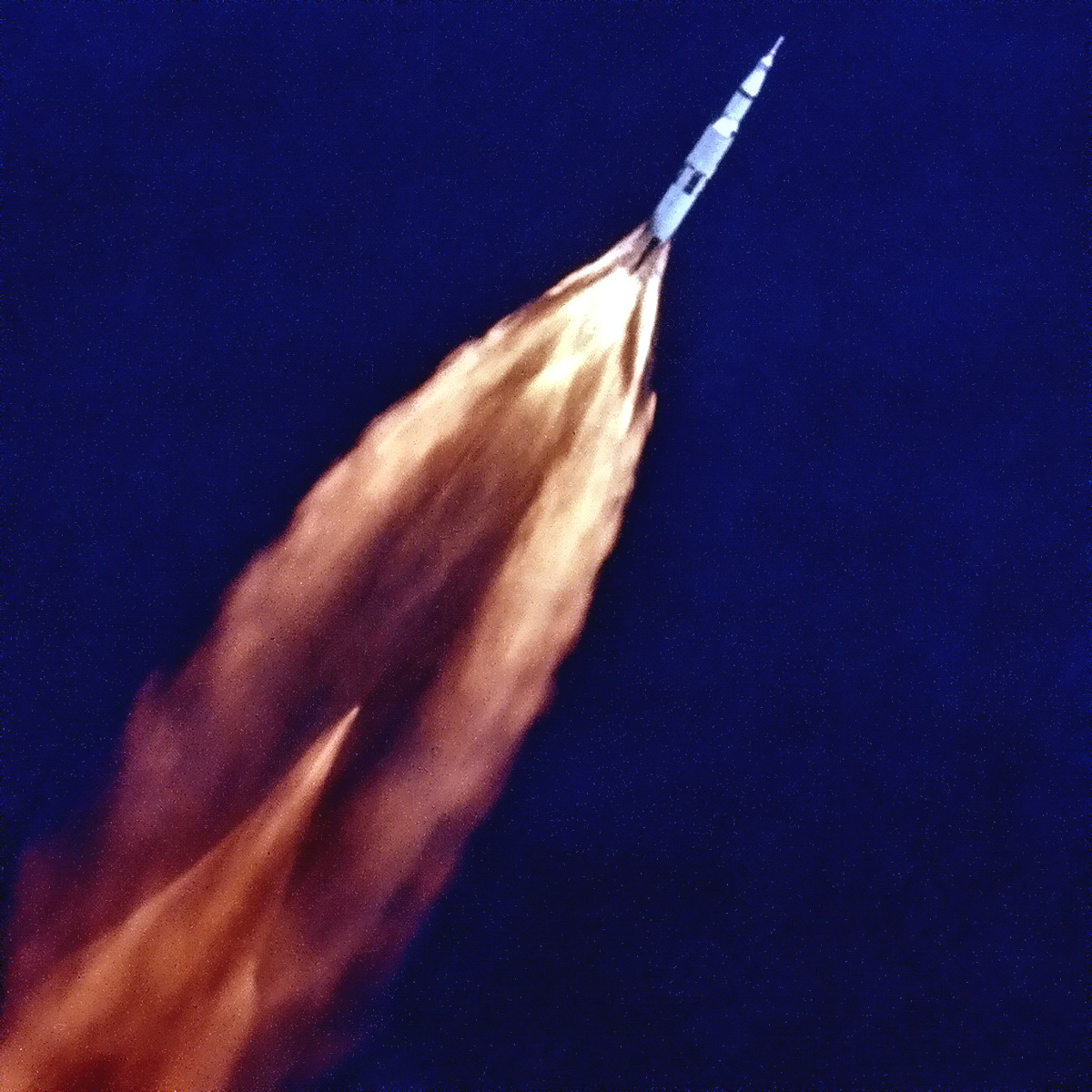
So on July 16, 1969 at 13:32 GMT (UTC), “a small step for one person” began. A rocket with an initial mass of 2 725 tons was raised to an altitude of 67 km and five engines of the 1st stage F-1 were dispersed to 2.75 km / s with a 690-ton thrust at the ground level. It is still the most powerful motor in history, because The Soviet RD-170 with a 740-ton load is a four-rocket engine in one “team”. Mass insanity in denial of lunar flights, among other things, is expressed in attempts to challenge the existence of an F-1 or reduce its performance.
One of these studies, if you can call it a stretch of facts on fantasy, belongs to Gennady Ivchenkov with his article "Assessment of F-1 characteristics, based on the analysis of heat transfer and the strength of the tubular cooling jacket" www.manonmoon.ru/articles/st65.pdf . Being a Ph.D., who studied rocket engines when he was a student and a graduate student at MVTU, he wrote a seemingly serious work, with the aim of proving that the main engine of Saturn-5 could not develop traction above 500 tons. From this it would follow that Apollos 8,10,11,12,13,14,15,16,17 did not fly to the Moon, and the human foot did not step on its dusty surface. But this attempt to pull reality behind the ears to the desired conclusion, like all the other fruits of lunar paranoia, was unsuccessful. Below the article www.manonmoon.ru/articles/st65.pdf is subjected to critical analysis and everywhere, where it is not said otherwise, we will talk only about it.
')
On page 1, the author demonstrates his prejudice, which sets the tone for the publication. " The Americans themselves were the first to raise this question almost immediately after the Apollo flights. Over the following years, a large number of direct and indirect evidence came to light that at least some of these flights were really staged ." The author makes it clear to the reader that "the Americans themselves" were serious specialists. On the founding fathers of the sect lunobortsy - Keising and Rene can be found in the article geektimes.ru/post/285236 . These “Americans themselves” were not specialists that were not entirely serious, but none at all!
Against the background of other “whistleblowers”, including Dr.Sc. A.I. Popov (he paid attention in the article geektimes.ru/post/274384 ), Gennady Ivchenkov looks preferable. However, his expert aplomb is not confirmed on closer examination. Like all Lunoborians, the author builds objections on his own mistakes and facts that are incomprehensible to him - Ivchenkov. As usual, this pseudo-scientific messivo is imbued with anti-Americanism and seasoned with journalistic sarcasm.
On page 2, the author writes. “ Now a kind of“ critical mass ”of evidence has accumulated, including the same photos and film materials, astronaut stories, allegedly moon stones, surprising researchers, and inconsistencies (and apparent nonsense) in the designs of“ Saturn-5 ”, its engines, ship“ Apollo "and the landing module ." In fact, the web has accumulated a huge array of quasi-scientific fabrications, which millions of profane people take as solid evidence that "the Americans did not fly to the moon."
" In particular, who guessed to design the Apollo service module from the sectors (like orange slices) and make a large (50 degrees around the circumference) longitudinal backup compartment in the service compartment, which must be loaded with ballast to balance the center of gravity (?? !!) ? "The author is outraged that he - Ivchenkov, never engaged in the design of space and other machines, does not understand the technical solutions inherent in Apollo? Three question marks and two exclamation marks reinforce this ridiculous pathos.
And further. " Who guessed to put there an overweight engine of AJ-10-137 11 tons in size and weight, when the Americans themselves write that it was twice as large as necessary, while a more suitable engine was (AJ-10, 5 tons) and weighed 200 kg less? Rocket engines with their problems are only part of the question . "
According to data from epizodsspace.airbase.ru/bibl/raketostr3/obl.html , the AJ-10-137 thrust was slightly less - 9.76 tons, and some sources give 9.3 tons. Following Wikipedia, the author claims that the thrust was twice that to enter the lunar orbit. Obviously, for a ship with an initial mass of more than 43 tons, an extra 200 kg of the weight of the LRE is not a problem. Approximately such a mass had a lunobul that Apollos 15, 16 and 17 carried with them. Even if this excessive thrust was not needed, this fact does not serve as a basis for declaring that " Rocket engines with their problems are only part of the question . " As will be shown later, these problems are in the author’s head!
In the English-language Wikipedia, referenced by the “LRE expert” (p. 3) en.wikipedia.org/wiki/Apollo_Command/Service_Module , this explanation is given. The initial profile of the mission assumed the landing of the entire Apollo spacecraft on the moon, so the engine was designed with a greater burden. At the time when the profile was changed, work on AJ-10-137 was already boiling, and the graphics of the lunar program were very hard. But I think that the engine with a margin of thrust was deliberately placed on the Apollo, because reliability was the main priority, not optimization. As is the case with moonbeats, Ivchenkov clings to trifles, trying to inflate fundamental problems from them.
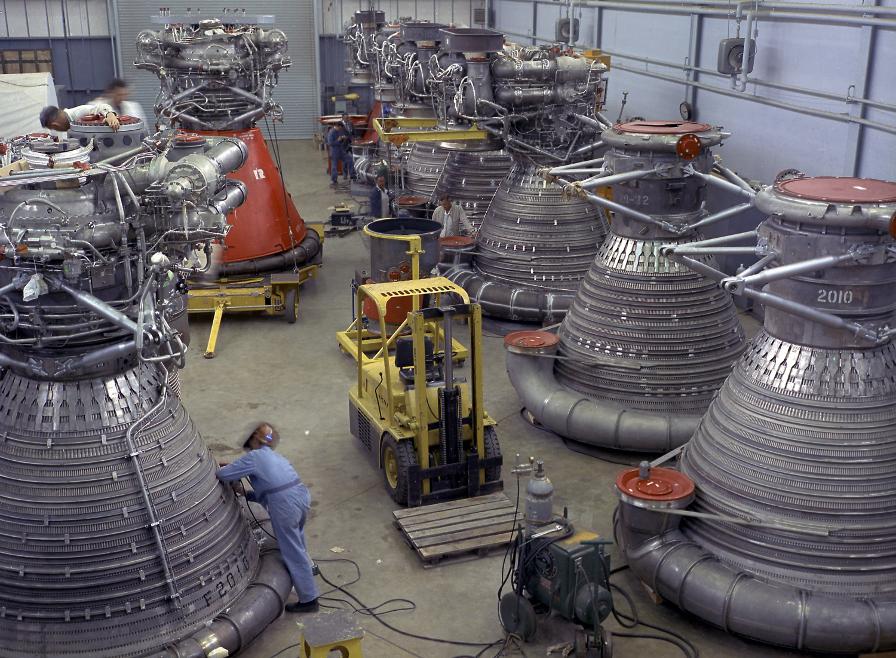
Engines F-1, which "was not" (without nozzle nozzles, which were mounted on the finished rocket)
Further on page 3, he claims. " In particular, the" tubular-jet "combustion chamber (hereinafter referred to as the CS) could not in principle provide the declared pressure and thrust of the F-1 engines. This is shown in detail in A. Veliurov's work ." Below will be shown completely different. Namely, that Ivchenkov’s arguments do not stand up to criticism. About this virtual moonbreaker you can read apollofacts.wikidot.com/hoax : people-velyurov. To form your own opinion, you had a quick look at the article free-inform.narod.ru/pepelaz/pepelaz-1.htm . Here is an indicative fragment from this slapstick.
" But the second flight of July 5, 1966 was orbital! The Americans write that the purpose of the AS-203 mission was to study" the behavior of liquid hydrogen in zero gravity. "And despite the usual minor trifles, the flight was successful ... But the Yearbook of the Great Soviet Encyclopedia ( TSB) (3) for 1967 describes the results as follows:
“The last stage (S-4B rocket) of the experimental Saturn IB SA-203 launch vehicle was put into orbit with fuel not fully consumed. The main tasks of the launch are the study of the behavior of liquid hydrogen in a state of weightlessness and the testing of a system that ensures the repetition of the main engine of the stage. After carrying out the planned experiments in the system for removing hydrogen vapor from the tank, the valves were closed, and as a result of an increase in pressure, the stage EXPLODED at the seventh orbit . ”
“ At that, the SA-203 stage spread out into 37 fragments! (2) You can congratulate NASA on successfully completing the flight program, almost like a famous song: except for nothing, your house and the stable burned together when the whole estate burned ... And the rest is beautiful marquise, all is well, all is well ! ".
The annual book of the Great Soviet Encyclopedia for 1967 really did write istmat.info/files/uploads/22100/17_str_496-540_nauka_i_tehnika_chast1.pdf . But if you read it in the original, without comments of Veliurov and hysterically screaming selections in color and size, it becomes clear that there was in fact no accident. Step blew deliberately! Perhaps for reasons of secrecy so that she somehow did not go to the Russians. Who and how counted the fragments? On this rhetorical question, we will part with Velura, returning to Ivchenkov on page 3.
“ In addition, according to the data on the Saturn-5 rocket in the American" advertisements ", its first stage is the best first stage" for all times and peoples. "It has 5 of the most reliable and powerful F-1 engines in the world, and besides, its weight perfection (the ratio of the weight of the filled stage to the weight of the empty stage) is the best and unsurpassed so far! It (again, according to the American "reklamki") is as much as 17.5! At that time, 1st stage H-1 was equal to 14.4, at Proton - 15, at 2nd stage of the Union - 15.2, at Atlas II - 16, at Shat la (when added to the weight of the weight of the tank and engine compartment of the motor) - 17 (for the latest version). "
And actually, what is the so-called “LRE expert” so surprised? The fact that the ratio of the weight of the filled 1st stage of Saturn-5 to empty weight is the highest naturally follows from the fact that this rocket was and remains the largest ever flown. The mass of the thin-walled shell, which is a rocket, is proportional to the square, and the mass of the fuel is proportional to the cube of its linear size. Therefore, their ratio grows with increasing size. Of course, this judgment should not be taken literally, because In reality, there are many other factors. But in general, it explains the feature of Saturn-5, to which Ivchenkov clung.
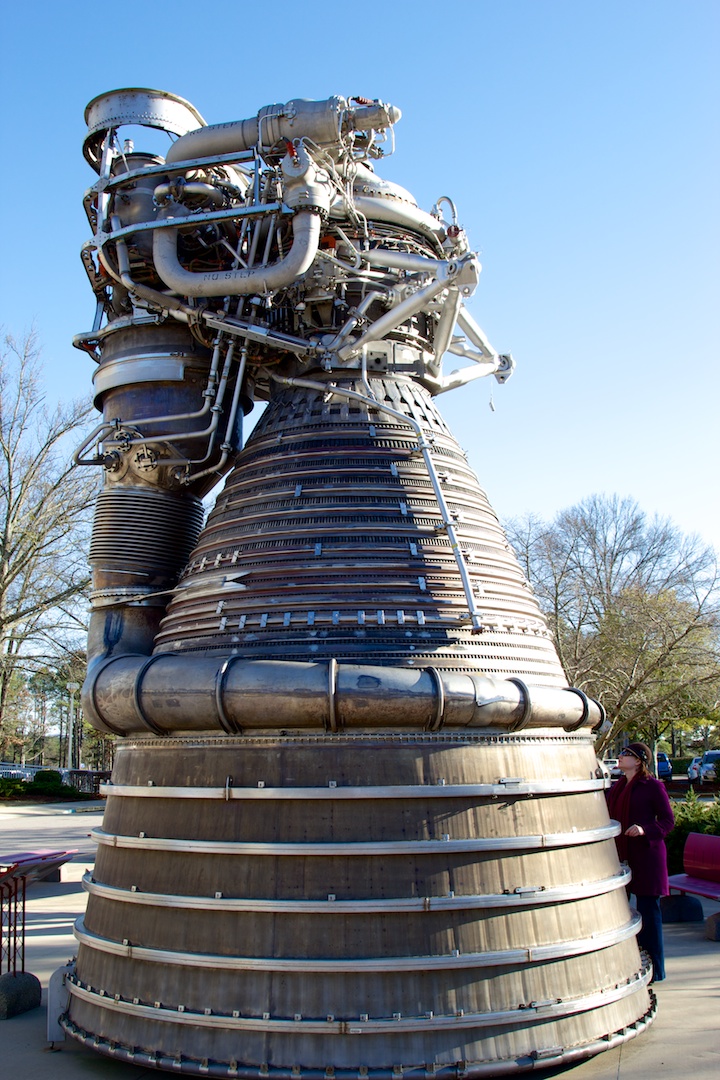
The main engine of Saturn-5 (with nozzle attachment)
The internal surfaces of the combustion chamber and the F-1 nozzles were made of longitudinal tubes through which 70% of the kerosene flowed before being fed into the nozzle head, thus providing cooling. In the picture the tubes are clearly visible - they are directed from the top down. The nozzle nozzle (ends a little higher than the girl) is cooled by the flow of gases from the exhaust of the turbine of the fuel drive with a temperature of about 920 K, which is much lower than the temperature in the combustion chamber (about 3 500 K). The line of supply of exhaust gas looks in the photo like a thick sleeve, covering the nozzle nozzles. The cooling tubes were made of heat-resistant nickel alloy Inconel X-750. The main content of www.manonmoon.ru/articles/st65.pdf is an attempt to prove that the tubes of this alloy could not work under pressure in the F-1 chamber (70 atm).
It is worth noting that some sources indicate less pressure, for example, 63 - 65 atm epizodsspace.airbase.ru/bibl/raketostr3/1-1.html . There is also given a temperature of 3,273 K, which is somewhat lower than what Ivchenkov uses. Given that he “balances on the edge,” these differences are significant. But we will use the author’s data, since they do not interfere with proving the failure of his fantasies.
The author compares the F-1 with the H-1, which was a reduced copy, but with the cooling pipes made of 347 stainless steel. Comparing the properties of these materials and the characteristics of the Ivchenkov motors, it seems to him, he proved that F-1 could not have a thrust above 500 m. On page 13 he writes. " Problems with alloys like Inconel X-750 were described in detail and highly professional by S. Pokrovsky ." Pokrovsky is a reputable among moonwrestlers, the late conspiracy theorist, who wrote the article www.manonmoon.ru/addon/22/inkonel.doc .
What it says about the Inconel X-750 alloy at first glance looks very solid from the point of view of solid state physics and metallurgy. But on page 2 of his article, Pokrovsky writes, “ It so happened that the author of this work is a laser scientist, who in his laboratory practice had for current needs to practically evaluate the absorption capacity of metals at a wavelength of 1 μm, which approximately corresponds to the spectral maximum of the radiation of the combustion chamber gases one." Thus, he was not a specialist in these areas. Pokrovsky focused on the fact that he was close - on the interaction of tubes of X-750 and solder with the radiation of hot gas.
On page 1 of his article, he writes. " The F-1 engine was built according to the traditional scheme of that time with a cooled combustion chamber from the tubes welded together. This solution was like a simple scaling of a sufficiently worked out circuit. That's right, but then illiterate nonsense begins." But not everything is in it allowed simple scaling. The growth of the size of the combustion chamber in the first approximation is proportional to the cube of linear dimensions, - leads to the same increase in the volume of hot radiating gases. The surface area receiving the radiation - grows like a square lin This means that the specific flux of radiant energy to the surface of the chamber wall increases with size . ”
The radiation power of a black body is determined by its surface area and temperature, but not by volume. Therefore, the radiation on the walls of the chamber does not occur from the entire volume of the gas, but only from the outer surface of the gas bunch. Inside, reradiation takes place - atoms absorb and emit photons with equal probabilities, which corresponds to thermodynamic (quasi) equilibrium. According to the Stefan-Boltzmann law, with an increase in the dimensions of the combustion chamber, the radiation flux density will not change, being proportional to the 4th degree of temperature. If the temperature in F-1 was the same as in H-1, then the flux of radiant energy to the chamber walls was of the same density.
At this point, the laser specialist demonstrated not only the expert’s aplomb, but also the ignorance of the radiation thermodynamics. That led to a gross error on page 4. " The power density in a pulse of 10 ^ 4 W / cm2 scale is close to the power density in the F-1 engine. And when starting? And when starting, the scale of radiant fluxes to the surface instantly increases to 10 ^ 4 - 10 ^ 5 W / cm2. These are typical scales of laser exposure . "
It is stated here that the radiation flux density from the surface of a gas bunch to the walls of the combustion chamber exceeds
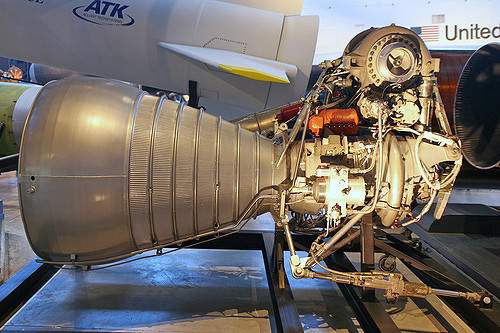
Engine H-1, the younger brother of the F-1
From p. 4 to p. 32, the author discusses the design of the F-1 engine and compares it with others, but proves the impossibility of postponing “for later”, limited to evaluative, categorical judgments.
On pp. 12-15, Ivchenkov argues that the cooling tubes of Inconel X-750 alloy were annealed, as a result of which they acquired a limit of elasticity of 2,400 kg / sq.cm (
On page 15 Ivchenkov writes. " In addition, the features of the Inconel X-750 can cause problems during short-term heating under pressure (in particular, during F-1 operation.) At the same time, crystallization begins on the firing surface of the tube with some hardening and, most importantly, an increase in hardness and, accordingly, fragility while the inner layers of the fire wall and the other wall are not affected. The pressure in the tubes increases and plastic deformation occurs, cracks may appear on the brittle surface . "
But how does the author know that these problems may arise with the F-1? Assume that the part of the tube that is in contact with the hot gas becomes more solid and brittle. In the absence of deformations, this will not manifest itself at all, but where will the deformations come from? The pressure of 70 atm is 2 orders of magnitude less than the elastic limit. Ivchenkov writes as about the fact that plastic deformation is underway, although in reality this is only an assumption. Apparently, he believes that uneven adjustment of the crystal structure of the alloy will cause tube bending. Given that the author is not an expert in solid state physics and metallurgy, there is no reason to trust these fantasies.
It is also worth paying attention to the word "may." They can - this does not mean that they will appear, given the brevity of the life cycle of the F-1 (less than 3 minutes). Moreover, on page 13, the author claims the exact opposite. "The increase in yield strength at 1200-1300 F is explained by the onset of crystallization during the operation of the alloy at these temperatures. This does not occur under short-term exposure to such temperatures (during short-term heating, for example, during F-1 168 sec), since the process of complete restructuring of the alloy goes slowly and takes hours . " Gennady Ivchenkov contradicts himself, as often happens with Moonbreakers.
Further on p. 15, the author once again formulates his fantasies, giving them the form of a firmly established fact. " It turns out that the Inconel X-750 is a problem material, in particular, due to the possibility of uncontrolled restructuring during operation ." Reception from the arsenal of conspiracy therapists: after speculating about what they think could have taken place, end with the categorical conclusion that it was so in reality))

The remains of the engine, which Ivchenkov calls F-1 (compare with the photo, where the girl)
On page 16, Ivchenkov writes about another, in his opinion, the fatal problem of the F-1 engine. " In addition, when developing the H-1 engine, additional problems arose related to the interaction of nickel alloys with kerosene RP-1 ." NASA, , (suspected) Inconel X-750, . H-1 347. , «» (fix) , , , c PR-1.
- , Inconel X-750 F-1. , «» -1 F-1 (. 16). " , F-1? RP-1 – , Inconel X750 – (70%), F-1 , -1 ". , , , «». ,
, «» ! . 16. " , Inconel, , . – ( ) F-1 ." , " " " " )) , , , .
. 18 . " , , -1 0,25 . F-1 0.457 , , ( ). " (. ).
. 21 — 22 , . " , , ( 1/3 1/10) 356. F-1 (.2), . 178 1/3 ( 1/8, ). ? NASA (Rocketdyne) 178 , 356 1/36 ".
, , ( ). , 60 . , F-1. () 9. , . , F-1? , , . -1, . , . , , , ))
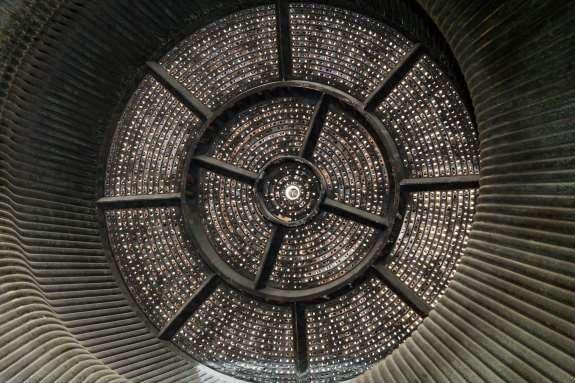
F-1 ,
, . 27 , , . , — , . , … . , . F-1 , . — .
(. 27). " , . , , « » , , , ( 50 ) , , ". ? ? , F-1 50 ? ? , , (« ») . 27.
" , « » ( , – . .11). , . , -, , -2 , , ."
: «» ? , , )) «» F-1, , . , F-1 -1, 0.2 , . , , .

,…
. 33 . , ,
Where
,
Where
« » ,
, (..
F-1 H-1 . , F-1

-5.
. 47 , «». . 47. " (, , ) 46–50 450 . F-1 70 690 – “” (Rocketdyne) ". ? — ))
. 48 « , NASA » . , , ( ) H-1.
. 49 — 53 . . , , . ? — .
. 56 — 58 , F-1 ( ). , - , ?
, , . , , , . . , .. ( 5) , . - , ( 4 ). , . , , . -5 !
, , . Rocketdyne, F-1, .
Source: https://habr.com/ru/post/402769/
All Articles